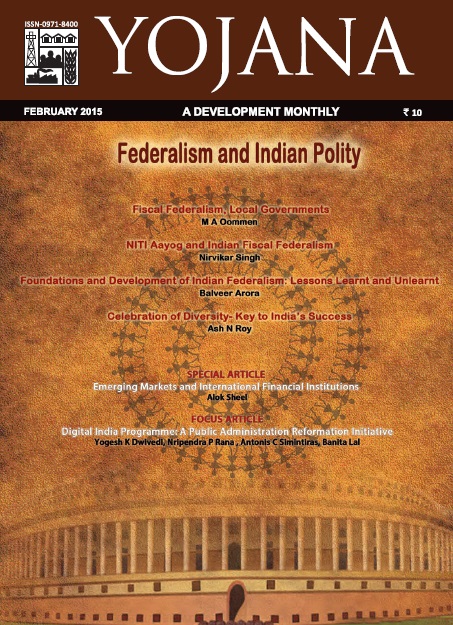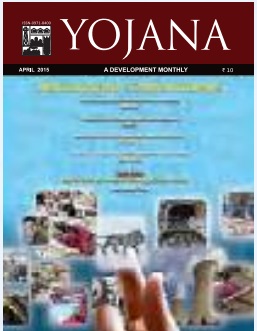
E-BOOK : Yojana Magazine, February 2015
CONTENTS
FISCAL FEDERALISM, LOCAL GOVERNMENTS
M A Oommen...........................................................................................6
WHY FEDERALISM? A PERSPECTIVE
Vinayak Narain Srivastava.....................................................................12
SPECIAL ARTICLE
EMERGING MARKETS AND INTERNATIONAL FINANCIAL INSTITUTIONS
Alok Sheel..............................................................................................17
FOUNDATIONS AND DEVELOPMENT OF INDIAN FEDERALISM: LESSONS LEARNT AND UNLEARNT
Balveer Arora .........................................................................................22
NORTH EAST DIARY ......................................................................26
FOCUS
DIGITAL INDIA PROGRAMME : A PUBLIC ADMINISTRATION REFORMATION INITIATIVE
Yogesh K Dwivedi, Nripendra P Rana, Antonis C Simintiras, Banita Lal ...........................................................28
EXPLORING UNION MODEL OF INDIAN FEDERALISM
Ajay Kumar Singh .................................................................................35
BETI BACHAO, BETI PADHAO ....................................................42
CELEBRATION OF DIVERSITY: KEY TO INDIA’S SUCCESS
Ash Narain Roy......................................................................................45
NATIONAL LITIGATION POLICY ...............................................50
NITI AAYOG AND INDIAN FISCAL FEDERALISM
Nirvikar Singh........................................................................................52
PREVENTING OPEN DEFECATION:
CHANGING MINDSETS IS THE PREREQUISITE
Rohit Gupta ...........................................................................................55
COOPERATIVE FEDERALISM IN INDIA: CONTESTS AND CONTRADICTIONS
V Mishra ...............................................................................................60
J&K WINDOW ..................................................................................64
FEDERALISM IN INDIA: POLITICAL AND FISCAL
PK Chaubey ...........................................................................................65
DO YOU KNOW? .............................................................................69
The idea of federalism as an organising principle between different levels of a state is quite old. Greek city states had it. Lichchavi kingdom of northern India in the 6th century BC is a celebrated example of a republican system. In the modern world, this continues to be the most popular system in larger countries like US, Brazil, Mexico and India. In fact, the European Union is a recent example of the idea of federalism being implemented at a trans-national level to leverage its various advantages in the economic sphere. It may perhaps look surprising that close to three dozen nations have been born after 1990 either by seceding from a larger federal structure or due to war and other factors. In a large number of cases, the mal-functioning of the federal structure gave rise to ethnic and nationalistic strife which finally culminated in the emergence of new countries. Scholars have noted that there is a ‘federalist ferment’ across the world but there is no single model of federalism. While Montesquieu talked about the ‘confederate republic constituted by sovereign city states’, federalists like James Madison pleaded the case for a ‘compound republic’ with an ‘overarching central government that can override against narrow local interests’. The architect of Indian Constitution, Baba Saheb Ambedkar believed that for a culturally, ethnically and linguistically diverse and heterogeneous country like India, federalism was the ‘chief mark’, though with a strong unitary bias. This understanding, which was shared by Pt. Jawaharlal Nehru, Sardar Patel and other national leaders stood at sharp variance with Gandhi’s idea of federalism who was a votary of decentralisation and devolution of power to the lowest unit of Panchayat. Globalisation has also deeply impacted the concept of federalism. As the countries of the world become more and more tightly integrated, the external influence of powerful financial and political entities tends to limit the freedom of action on the part of states. It is often reflected in the weakening of public institutions. This process has also generated a phase of ‘competitive federalism’ where provincial governments compete with the centre to attract investment, garner capital and technology for their benefit. India, on the other hand, has taken forward the path of cooperative federalism by gradually loosening the control of the central government over the states in financial matters and restricting itself more and more to policy issues in certain areas only. It can be argued that cooperative federalism could be the path to make best use of the ‘different advantages of the magnitude and littleness of nations’ as Tocqueville had once remarked. It is important to underline that federalism, in its true sense, can be successful only by broadening the base of democracy and deepening its roots. In the case of India, a deep respect for diversity of languages, cultures, ethnicity and religion as hallmarks of its political and civilizational existence could nourish federalism and strengthen the nation. It is the only way India could take forward its great tradition of federalism which goes back to the time of Buddha. Let us end with a story. Around 5th century BC, the republican states of Lichchavi and Sakya had an institutional system called Santhagara which was used to debate issues of vital importance to the republic, including disputes between various constituents of the republic. Buddha was initiated into the Sakya Santhagara at the age of 20. When he was 28, there was a dispute over sharing of water of Rohini river between the Sakyas and Koliyas. The Sakya military commander was in favour of war on Koliyas which Siddhartha opposed. But the peace proposal of Siddhartha was defeated miserably during voting. Siddhartha had to face exile. Buddha may have been defeated and exiled but the idea of the republic and settling of disputes without the use of force has survived. The republican spirit has survived as a guiding spirit for nations. And finally, it is the time to say adieu to the readers of Yojana with whom the last two years have been a period of exploration and sharing of ideas on an exciting range of subjects. Yojana would continue to provide stimulating and thought provoking material to involve the readers in this great journey of nation building.
Fiscal Federalism, Local Governments





